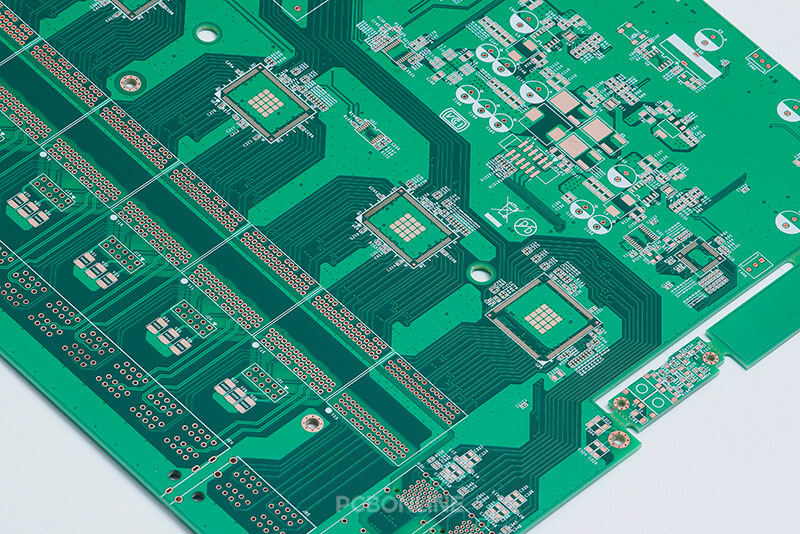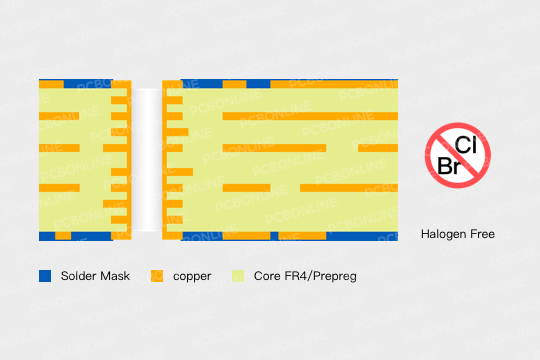As the need for environmental protection becomes more and more urgent, more electronic products adopt halogen-free PCBs, which are safe for health and recyclable. This article will tell you what a halogen-free PCB is, its advantages and manufacturing, and why halogens in PCB are not welcome.

What is Halogen-Free PCB
According to IEC 61249-2-21 and JPCA-ES-01-2003 standards, halogen-free copper clads should have Cl (chlorine) and Br (bromine) of respectively within 0.09 wt% (weight percent) (900ppm) and the toll of Cl and Br within 0.15 wt% (1500ppm). So we can define halogen-free PCBs as printed circuit boards having chlorine within 0.09 wt% (900ppm), bromine within 0.09 wt% (900ppm), and the toll of halogens within 0.15 wt% (1500ppm).
Halogen-Free PCB Materials
Halogen-free FR4 materials include but are not limited to Panasonic's R1566, R1566WN, R1566W, R1566S, Ventec's VT-447, ITEQ's IT-170GRA1TC, Isola's DE156 and GreenSpeed series, ShengYi's S1550G, S1165, S1165M, S6015.
Halogen-free PCB substrates usually refer to halogen-free FR4 materials that use P (phosphorus) or N (nitrogen) to replace halogens. The ink used for the solder mask of the PCB is halogen-free.
What is Halogen in PCBs

In the periodic table, halogens are the 6 elements that constitute Group 17 (Ⅶ), and they are F (fluorine), Cl (chlorine), Br (bromine), I (iodine), and At (astatine). Astatine is a radioactive element and is not used in electronic products, so halogens usually mean only F, Cl, Br, and I.
In the past, the halides PBB and PBDE were used in copper-clad as flame retardants for PCBs. Fortunately, PBB and PBDE were banned in copper clads for PCBs. However, bromine flame retardant is still used for halogen-containing PCBs such as normal FR4 PCBs and CEM-3 PCBs, and the flame retardant is usually brominated epoxy resin.
Why Are Halogens in PCBs Harmful to Health
When PBB and PBDE are burned, they release highly toxic black smoke that contains dioxin and benzofuran. For this reason, both the EU and China ban PBB and PBDE in electronics products.
However, there are no laws in the world to ban bromine flame retardants other than PBB and PBDE in copper-clad used in PCBs. At temperatures of more than 200℃, the traditional FR4 PCBs and CEM-3 PCBs that use tetrabromobisphenol A flame retardant release a small amount of HBr (hydrogen bromide). When they are burned, a lot of brominated smoke is generated. Though FR4 PCBs and CEM-3 PCBs that contain halogens are allowed to be used, they are not halogen-free PCBs.
How Do Halogen-free PCBs Be Fire-Resistant
![]()
As mentioned, halogens are used as a flame retardant in PCBs, so how do halogen-free PCBs be fire-resistant without halogen flame retardant?
Ceramics and metals are non-toxic and have high-temperature resistance. Ceramics PCBs are highly fire-resistant by nature. Aluminum PCBs and copper substrate PCBs are also fire-resistant, though they have a PP layer between the metal substrate and circuit layer. What halogen-free PCBs that need a little more explanation are those that use halogen-free flame retardant.
Most halogen-free PCB substrates use P (phosphorus) and/or N (nitrogen) flame retardant. For the halogen-free PCBs using P flame retardant, when the phosphorus-containing resin is burned, it becomes meta-polyphosphoric acid which has strong dehydration properties, and this forms a carbonized film on the surface of the resin. In this way, the air and the resin are insulated, and the resin stops burning.
For the halogen-free PCBs that use P and N compound flame retardant, when phosphorus and nitrogen compound containing resin is burned, it releases incombustible gas, and this stops the resin from burning.
Advantages of Halogen Free PCBs
- Halogen-free PCB substrates have better electrical insulation. P and N have smaller polarity than halogens, and thus halogen-free materials have reduced polarity compared with bromine-containing materials. For this reason, halogen-free PCBs can withstand a higher electric shock.
- Halogen-free PCBs have a smaller thermal expansion coefficient. P and N replacing Halogens leads to a larger monomer molecular weight of the PCB, and the mobility of molecules is lower than that of conventional epoxy resin. Thus, halogen-free PCBs have more thermal stability and less thermal expansion than traditional PCBs that contain halogens.
- Halogen-free PCBs have a higher TG. TG is the glass melting point, and a higher TG means the PCB can work at higher temperatures and be used for higher-power applications.
- Halogen-free PCBs have a smaller moisture absorption rate. P and N compound epoxy resin have a smaller chance to form hydrogen bonds with hydrogen atoms in water than halogen epoxy resin does. So the moisture absorption of halogen-free PCBs is less than normal PCBs using halogen flame retardant.
Thus, compared with normal PCBs using halogen flame retardant, halogen-free PCBs have more stability, reliability, and improved performances.
Halogen-Free PCB Manufacturer to the Highest Level -- PCBONLINE
PCBONLINE provides turnkey halogen-free PCB manufacturing and assembly to the IPC-A-610 Class 3 standards. You can order ceramic PCBs, aluminum PCBs, copper substrate PCBs, and halogen-free FR4 PCBs from PCBONLINE with the most cost-effectiveness, including flexible PCBs, rigid-flex PCBs, RF microwave PCBs, etc. From PCB copper-clad laminates, silkscreen, components, soldering flux, the assembly lines, to end-product assembly and PCBA shipping, the one-stop solution is fully halogen-free and compliant with RoHS.

PCBONLINE is an advanced PCB manufacturer providing one-stop PCB solutions to clients around the globe. Engineers, electronic solutions companies, research institutes, and business makers can order halogen-free PCBs and assembly online and track the whole manufacturing process from the customer system. All the components and PCB materials are traceable and halogen-free.
Solutions experts at PCBONLINE will provide one-on-one engineering support and services to you. Now get a quote online or contact PCBONLINE by email or online.
What's Special in Halogen-Free PCB Manufacturing and Assembly
Drilling halogen-free PCBs needs a stronger power
Compared with normal FR4 and CEM-3, halogen-free FR4 materials have increased mechanical strength, so the PCB manufacturer elevates the drilling power to drill holes on halogen-free circuit boards.
Shortened soaking time in the alkaline stripping solution
Halogen-free FR4 materials have a lower resistance to alkali than normal FR4. When etching the halogen-free PCBs, the soaking time in an alkaline stripping solution should be shortened in case of white spots on the PCB substrates.
Higher temperatures for reflow soldering during halogen-free PCB assembly
Halogen-free PCBs are usually also lead-free PCBs. Lead-free assembly requires 260℃ for reflow soldering, and this is 20℃higher than lead-containing PCB assembly.
FAQs about Halogen-Free PCBs
No. Halogen-free means Cl ≦ 900ppm, Br ≦ 900ppm, and the toll of Cl and Br ≦ 1500ppm. RoHS requires the Pb < 0.1%, Hg < 0.1%, Cd < 0.1%, Cr6+ < 0.1%, PBB < 0.1%, and PBDE < 0.1%.
No. Halogen-free is not mandatory yet but is a trend around the globe. Halogen-free materials are recyclable and environment-friendly.
Because in halogens, only Cl and Br are used as halogen flame retardants widely used in consumer and commercial electronic products, and brominated retardants are the most common.
Conclusion
Halogen-free PCBs have no differences with other PCBs other than the requirements of the weight percent to chlorine within 0.09 wt%, bromine within 0.09 wt%, and the toll of halogens within 0.15 wt%. Halogen-free PCBs have better performances such as a higher TG, lower thermal expansion coefficient, and lower moisture absorption rate, and the halogen-free PCB substrates are recyclable and safe. In the future, halogen-free PCBs will be used more and more. In the future, halogen-free PCBs will be used more and more. This article also recommends a reliable halogen-free PCB manufacturer, PCBONLINE. If you are looking for halogen-free PCB manufacturing and assembly, PCBONLINE is one of the best halogen-free PCB houses.




